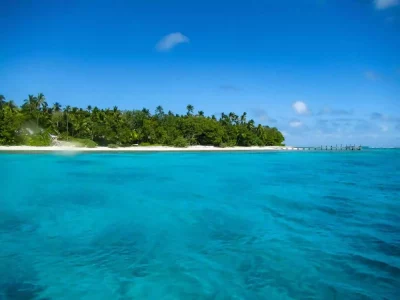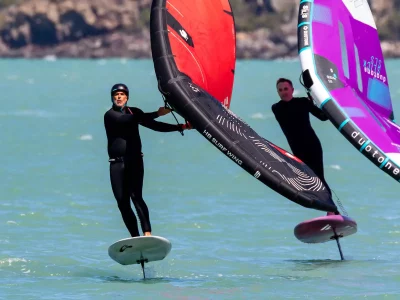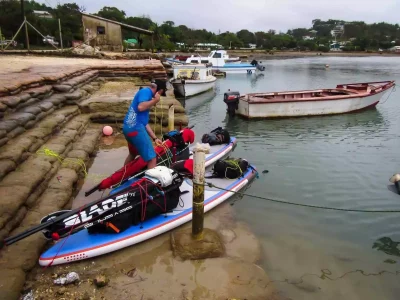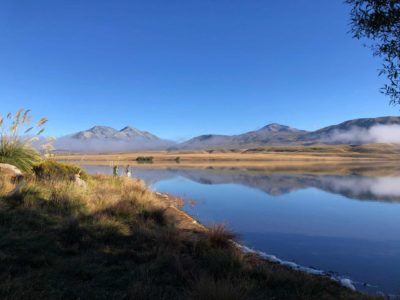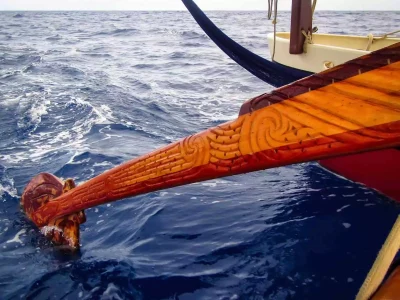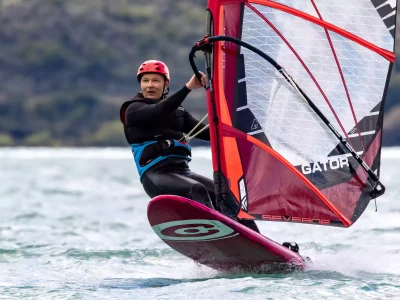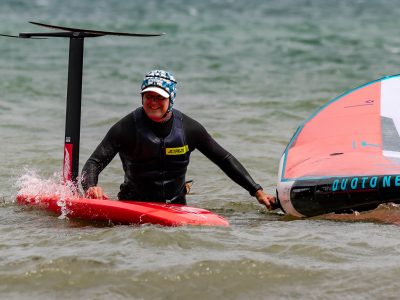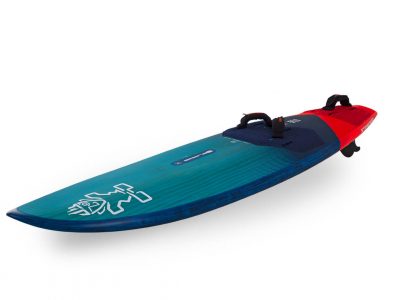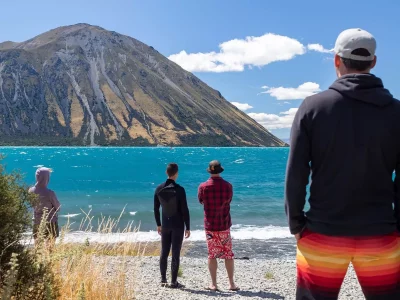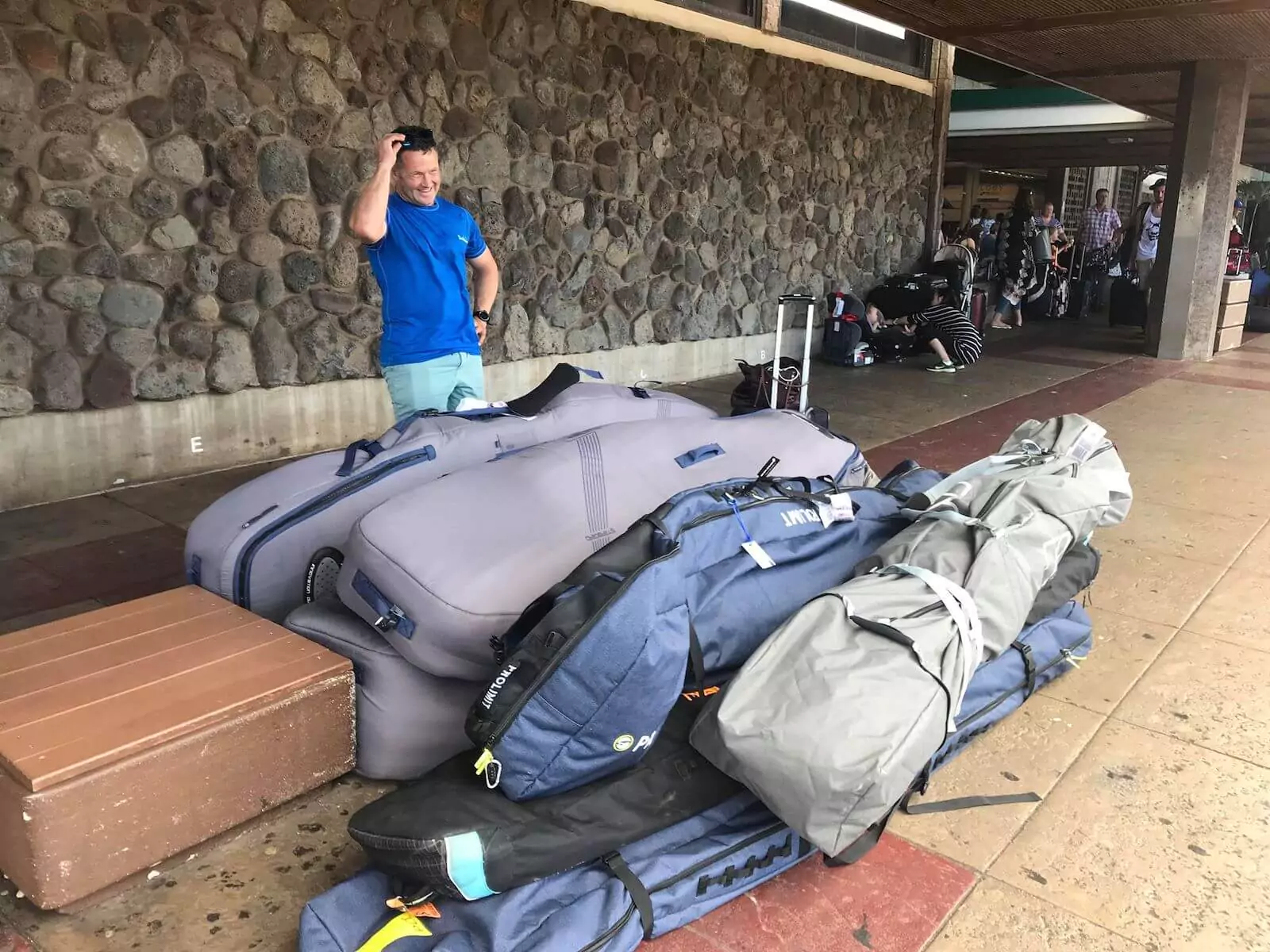
FREQUENTLY ASKED QUESTIONS
Find Answers Quickly
FAQ | Travelling New Zealand
The short answer is no. Not the centres like you would find in the Northern Hemisphere. There are a few watersports schools located at the main city beach locations. Board rentals are generally possible by the hour, half-day or day, but are not often at the prime locations.
Water Nomads New Zealand is the closest to a dedicated Watersports Rental Centre in New Zealand, just without the “centre”. Rather than being at a specific location, we offer flexibility to suit your travel plans. The ability to hire premium watersports gear from any main centre. That you can then take on your travels, and thus ride all those amazing spots you always heard about.
Water Nomads New Zealand also run Surfari Trips in prime locations that are optimised for the weather. You can join a Surfari Trip and rent the Watersports Equipment of your choice for the duration of the Surfari. Then opt to hire it longer as you will be familiar with the location. This is possibly the best value option ever! We also offer a Custom Surfari option where we take charge of all the planning!
Yes! Although the New Zealand population is relatively small and sparse, thus the watersport community smaller, you will meet other ‘frothers’ as keen as you are.
If you don’t find anyone where you are and the conditions seem good, a) you are maybe at the wrong spot, b) you are really remote and there is actually no-one there, or c) you have discovered potentially a new awesome spot!
No, you do not need any form of licence to Windsurf / Wingsurf / Wingfoil / Surf / SUP / Kitesurf.
You do however need to conform to the local government (Council) bylaws. Although uncommon, these can restrict certain access (i.e. Rahui) for particular users and/or specify user safety equipment required.
Example: some local councils require lifejacket for vessels under 6 meters. This bylaw can mean you need a PFD to paddle a SUP (despite wearing a leg leash). However most foilers tend to wear an impact vest which is a sufficient buoyancy aid, and windsurfing seems to avoid any scrutiny.
New Zealand (Māori: Aotearoa) is located in the south west Pacific Ocean. Consisting of two main islands North Island (Te Ika-a-Māui) and South Island (Te Waipounamu) and over 700 smaller islands. It is the sixth-largest island country by area, covering 268,021 square kilometres making it slightly smaller than Italy and slightly larger than the United Kingdom. The population of New Zealand is currently at 5.2 million approximately, with around 1.7 million in Auckland.
New Zealand is a very long and narrow country and as such, we enjoy an incredible amount of coastline. This means that no matter where you are in the country, you are never too far from the beach. The approximate length of the New Zealand coastline is 15,000 km (9,300 miles) making it the 9th longest in the world. The coastline borders the Tasman Sea and the Pacific Ocean.
The length of New Zealand on its north-north east axis from North to South is 1,600 km (1,000 miles).
In terms of the widest point in New Zealand from coast to coast, that’s found at the ‘chunky’ bottom of the North Island between New Plymouth and Napier and covers 450 kms. That means that you are still never more than 225 kms from the coast no matter where you find yourself in New Zealand which is pretty awesome.
Sea breezes develop along coastal parts of New Zealand when air temperatures over land becoming higher than air temperatures over the sea. These sea breezes may develop throughout the year, but are most common in summer and least common in winter.
In Wellington, winds are channelled by nearby Cook Strait, such that wind directions recorded are almost exclusively from the north-northwest and south-southeast. Invercargill is similarly influenced by nearby Foveaux Strait, with westerly winds there strengthened as they are channelled through the strait, such that most of Invercargill’s strongest winds are recorded from the westerly direction. Christchurch residents will be familiar with the northeast sea breeze that develops on fine weather days, and this is the dominant wind direction recorded in the city. Gusty winds occur most frequently in the mountain ranges and exposed coastal locations of New Zealand.
Wellington is undoubtedly the windiest city in the country, and experiences an average of 198 days per year with wind gusts exceeding 61 km/hr (33 knots). This is considerably more than Invercargill, itself considered a windy location, where on average 109 such days per year are recorded. Wellington’s highest wind gust on record was 198 km/hr on 10 April 1968, and was associated with a weather system now known colloquially as The Wahine Storm. New Zealand’s highest recorded wind gust is 250 km/hr, observed at Mt John (Canterbury) on 18 April 1970.
There is notable variability in mean monthly wind speeds over the course of a year in New Zealand, where wind speeds are typically highest from around mid-spring (October) to mid-summer (January), and lowest from mid-autumn to the end of winter (April to August).
In theory you could drive the North Island from tip to toe in around 14 hours and the South Island in around 12 non-stop. The length of New Zealand from top to bottom using the most direct road route is 2,090 km (1,298 miles). This route would take you from Cape Reinga at the top of the North Island to Stirling Point lighthouse at the bottom of the South Island. Including the ferry (that you would need to take from Wellington to Picton), the drive would take you about 30 hours if you could drive non-stop so allow another hour or two for petrol and bathroom breaks.
Taking the coastal route around New Zealand and assuming a similar average driving speed as you would achieve driving the most direct route (approx. 70 kmph), it would take you around 214 hours to drive around the whole coastline which is truly an epic road trip!
About two-thirds of New Zealand’s coastline is hard rocky shore, with soft shores of sand or gravel covering the remainder. Some 80% of it is directly exposed to the sea, with the rest in harbours and estuaries. The western and southern coasts are more exposed than the eastern and northern coasts.
New Zealand is roughly midway between Antarctica and the tropics, lying between latitudes 34° and 47° south. It is on the edge of the ‘roaring forties’, a zone of high winds and stormy seas. New Zealand’s climate varies wildly. The far north has subtropical weather during summer, while inland alpine areas of the South Island can be as cold as -10°C (14°F) in winter.
However, most of the country lies close to the coast, which generally means mild temperatures year-round. The average New Zealand temperature decreases as you travel south. January and February are the warmest months, and July is the coldest month of the year.
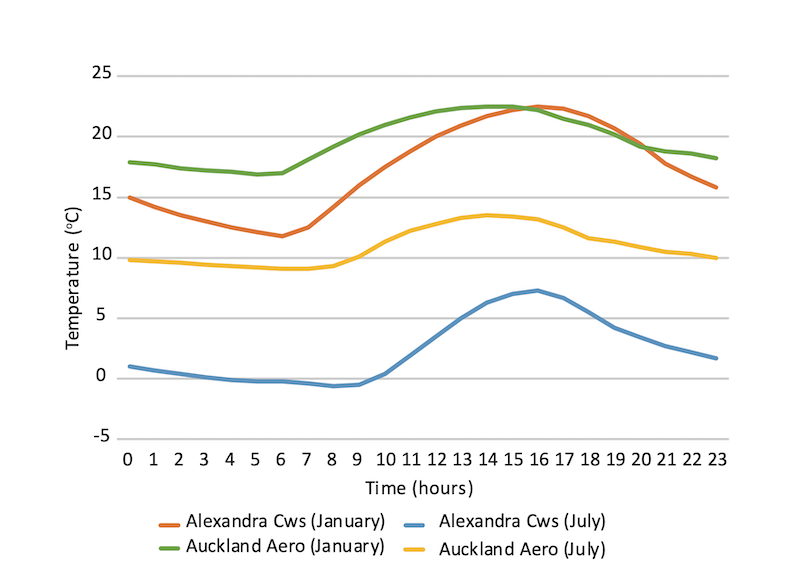
Alexandra is situated in Otago, the lower central South Island, thus has very cold winters and hot dry summers. Whereas Auckland (New Zealand’s largest city) is in the upper North Island where the East and West coast becomes the narrowest making for a more mild consistent temperature variation.
Most places in New Zealand receive over 2,000 hours of sunshine a year, with the sunniest areas—Bay of Plenty, Hawke’s Bay, Nelson and Marlborough—receiving over 2,350 hours.
New Zealand experiences relatively little air pollution compared to many other countries, which makes the UV rays in our sunlight very strong during the summer months. In order to avoid sunburn, we highly recommend you should wear sunscreen, sunglasses, and a sunhat when you are in direct summer sunlight, especially in the heat of the day (11 am – 4 pm).
While summer is sunnier than the other seasons, most regions in New Zealand have a relatively high proportion of sunlight during the winter months.
To learn more about safety in the New Zealand sun, visit Sun Smart.
Most apps you may already use will provide forecasting for New Zealand. Local New Zealand weather forecasting is provided by:
Windguru, Windy, Windy.app, Yr are all popular forecasting apps used by most locals.
The most comprehensive we use is Predictwind, however to get the most out of this the paid version is brilliant.
Another excellent app to have handy is Coastguard NZ
Ultimately it depends on what you wish to achieve.
For wind sports (windsurfing to wingfoiling), Spring (September to November) tends to be most consistent wind, and not as wild as winter (June to August). Summer (December to February) provides sweet thermal winds along most of the coastlines and mountain lakes. Finally Autumn (March to May) is generally the most settled period, meaning little wind as a rule. However, our weather is mostly controlled by frontal systems so can be anything but ‘normal’ and very unpredictable at times!
Surfing you can do anytime time of the year, from storm chasing southern ocean swells in winter to long boarding gentle east coast breaks and everything in between.
The temperature of the water in New Zealand varies depending on the location and the time of year. In general, the water is coolest during the winter months (June through October) and warmest during the summer months (December through February). The average water temperature in New Zealand ranges from about 13-20 degrees Celsius (55-68 degrees Fahrenheit), although it can vary depending on the location and other factors. The water is generally coldest on the south coast of the South Island, where it can dip as low as 10-12 degrees Celsius (50-54 degrees Fahrenheit) in the winter. The water is generally warmest on the north coast of the North Island, where it can reach temperatures of up to 25 degrees Celsius (77 degrees Fahrenheit) in the summer. Overall, the water in New Zealand is cool, but it can be warm enough for swimming in the summer months.
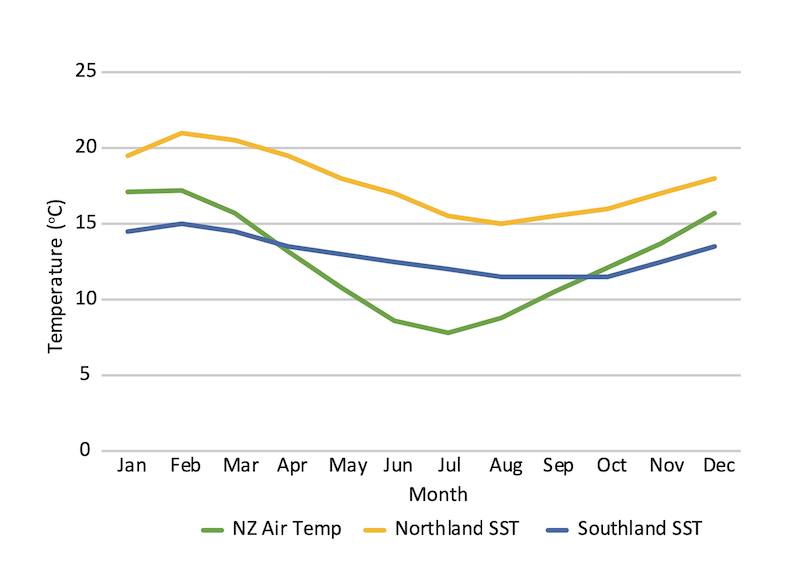
Its worth noting that although the South Island lakes are not that inviting in winter, in summer they can be as warm as 15-18 degrees Celsius, which is similar to Northland sea temperatures in winter. You will begin to see the reasons for our trip timing.
NB: Lake Wakatipu in Queenstown is very popular for windsurf, wingfoil and kite. Its very accessible as a tourist destination being the adventure capital of New Zealand. As the lake is very deep, the water temperature remains around 10-12 degrees Celsius even in mid summer. We highly recommend a good 4/3 wetsuit as minimum and suggest an impact vest for added flotation if something goes wrong.
Like a lot of things, this can vary between different people for the same conditions. As a general rule, a quality 4/3 full length steamer will have you comfortable all year round. If you’re intending staying north in summer a 3/2 short wetsuit is perfect (the brave will be seen in board shorts and a rash shirt). Whereas if you’re heading south anywhere around winter you may prefer a 5/3. For the South Island it never hurts to carry neoprene hood just incase. Booties are a personal choice and not absolutely necessary. Be aware though, much of the coastal areas have Oyster shells covering rocks which can be razor sharp if you slip.
It greatly depends on your experience and fitness. If you are not very familiar with a spot, then air on the side of caution!
“If in doubt – stay out”
The New Zealand coast can be wild and dangerous if you do not know the changes in water state with tides, rips and changeable wind conditions. Try and find the locals, in the more remote places they are usually super keen to have company and just as eager to share their local knowledge.
Simply treat other beach users as you would like them to treat you, it is amazing what a smile / wave / nod can do…
Beach Courtesy
- It is advisable to set up your rig, launch and return in an area which is well clear of other beach users.
- Slow right down when returning so as not to alarm people who are unfamiliar with the manoeuvrability of boards.
- Always be courteous or you may give windsurfing a bad image.
Collision regulations and by-law
It is advisable to avoid busy waterways and shipping lanes, but if it is unavoidable, be considerate and keep up foiling and windsurfing’s good image. Sailboards are still governed by rules for sailing vessels and it is an offence not to observe these:
- A vessel must restrict its speed to 5 knots if:
- within 200 metres of a public beach
- within 30 metres of persons in the water
- within 30 metres of all other craft
- All vessels over 500 tons in harbour limits have right of way.
- Overtaking vessels give wayHead on – each vessel shall alter it’s course to starboard (ie. to the right).
- Windward vessel gives way.
International Yacht Racing Rules
- A sailboard coming in to the beach/ramp shall keep clear of a sailboard leaving it.
- A sailboard on port-tack (left hand closest to mast) shall keep clear of a starboard-tack sailboard (right hand closest to mast).
- An overtaking sailboard shall keep clear of the overtaken sailboard.
- Except when gybing around a mark, a sailboard that is tacking or gybing(changing course) shall keep clear of a sailboard on a tack.
- When both sailboards are tacking or gybing at the same time, the one on the port hand side shall keep clear.
Wave Sailing Rules
- A sailboard picking up a wave first has right of way.
- When two sailboards catch a wave at the same time, the one closest to the peak has right of way.
Dial 111 in an emergency.
Fire, police, and ambulance services. Calls are free. Be aware that many places in rural New Zealand and our National Parks do not have reliable cell phone reception. If you are remote, hire a distress beacon so you can summon help if you need it. We can assist with this on request.
An app we recommend is AED Location. An Automated External Defibrillator (AED) can increase someone’s chance of survivaling a heart-attack by up to 80% if applied immediately. Over 12,000 locations throughout New Zealand are now mapped on this website and the Android and iPhone apps.
Our Surfari Trips are currently catering for Windsurf / Wingsurf / Wingfoil / Kitefoil Watersports with Surf / SUPSurf / SUP’ing accessible on the no wind days.
At this point in time we have no ‘surfing’ specific trips on offer, however there is always the opportunity to catch a surf wave should you desire. Most of our trips are at or very near the best surf breaks. Have a look our Surfari Trips and we will be happy to discuss making one happen for you and your friends!
No sorry, we are not a school.
Our expectation is that you have an intermediate to advanced level in your chosen sport. We can cater for beginner level that have progressed from basic lessons on our Surfari Trips and are keen for lots of water time to practice new skills.


